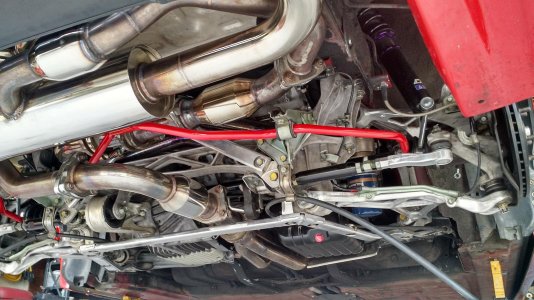Looking for the best deal in exhaust headers to replace the cast iron OEM exhaust manifolds. I'm planning on keeping the OEM cats and exhaust. My search has led to no obvious choices other than those offered by SOS. I'm looking for best price, quality and ease of installation. Thoughts?
-
Protip: Profile posts are public! Use Conversations to message other members privately. Everyone can see the content of a profile post.
You are using an out of date browser. It may not display this or other websites correctly.
You should upgrade or use an alternative browser.
You should upgrade or use an alternative browser.
Best 1991 Exhaust Headers
- Thread starter Dr. JL
- Start date
- Joined
- 14 September 2012
- Messages
- 201
If you're gonna keep it OEM, then the only answer is the newer OEM manifolds.
The problem with 97-99 spec headers is that you can't keep your oem cats.
I bought TopSpeed Headers because a lot of people here on the forum wrote good things about them. I have NEVER EVER seen such a mess of header. They did not fit AT ALL. Hit the gearbox, the swaybar bracket, the ac compressor, the front lower sub frame, rear header too short ..... Without a friend who is a skilled welder with a lift, no way this crap would fit.
Now I bought the SOS headers. They look awesome! Quality is like 500% better than the topspeed ones. They offer a set as direct replacement of the 91-94 that even removes the prone to fail flex pipe. Best bang for buck header if you want a headache free install imho.
You might want to look at the Pride headers. Have not seen them in person but I have a Pride exhaust and the quality is good. Maybe a bit cheaper than SOS but good option to think about.
Bernhard
I bought TopSpeed Headers because a lot of people here on the forum wrote good things about them. I have NEVER EVER seen such a mess of header. They did not fit AT ALL. Hit the gearbox, the swaybar bracket, the ac compressor, the front lower sub frame, rear header too short ..... Without a friend who is a skilled welder with a lift, no way this crap would fit.
Now I bought the SOS headers. They look awesome! Quality is like 500% better than the topspeed ones. They offer a set as direct replacement of the 91-94 that even removes the prone to fail flex pipe. Best bang for buck header if you want a headache free install imho.
You might want to look at the Pride headers. Have not seen them in person but I have a Pride exhaust and the quality is good. Maybe a bit cheaper than SOS but good option to think about.
Bernhard
Last edited:
- Joined
- 14 September 2012
- Messages
- 201
So the 3.2L manifolds will work on my C30A?
Yes, but you will need adapters to fit with your cats.
SoS and Comptech are great choices but a waste of money if you're not going to do anything else.
And that's not an opinion.
Unfortunately with aftermarket headers, your will not feel much gain in performance. 15 hp is barely noticeable. If you really want a noticeable gain, forced induction is the key. For me the aftermarket exhaust did in fact open up the motor to breathe. Problem is, there is no big chest behind it to exhale. Exhaust swap outs for me prior to F.I. Just created more noise and less bottom end performance. In retrospect it sounded meaner and gave the affect of a fast car, but still slow as molasses. I went with DC headers. Carb legal and only set me back 1050.00Thanks for the inputs. I talked with Chris at SOS today for quite a while. I settled on the SOS headers/OEM exhaust for the time being. I understand the OEM exhaust will limit the possible header hp increase. Someday I'll upgrade.
Last edited:
That 14 HP are absolutely noticeable. Especially in the midrange. The engine feels a lot happier around spirited cruising rpms. My obviously subjective impression is that the car feels less powerful at top end because mid range is so much better with the headers. Top end probably hasn't changed much relative to the midrange. I have a baseline dyno with stock headers so I can compare when I find time to do another dyno run.
Bernhard
Bernhard
Biggest improvement in the 91-94 are long tube headers. Best is probably the old GT-One, Fujitsubo, and/or RFY. They all have appropriate equal length and efficient collectors. Comptech, now CT Engineering, are the only ones that are CARB Approved. That's important for Californians if they want to stay legal. I use Comptech with my CTSC and find no reason to switch.Getting them ceramic coated was a huge help.. FYI.
I would go RFY if I could order again.
I would go RFY if I could order again.
Last edited:
Getting them ceramic coated was a huge help.. FYI.
A huge help to . . . ? Engine-bay temp? Oil temp? Something else?
A huge help to . . . ? Engine-bay temp? Oil temp? Something else?
Engine bay temps mostly
Correct in the term of, "feels" a lot happier. However, 15 hp for over 2,000 dollars with installation is worthless in my opinion. Only reason I did headers on mine is because I had plans of a blower. I felt zero difference in performance even though a Dyno proved 14 hp gain and this is also with addition of a cat back. It just made the motor scream louder. Didn't really improve any faster acceleration for me. The placebo effect. Louder motors faster car.That 14 HP are absolutely noticeable. Especially in the midrange. The engine feels a lot happier around spirited cruising rpms. My obviously subjective impression is that the car feels less powerful at top end because mid range is so much better with the headers. Top end probably hasn't changed much relative to the midrange. I have a baseline dyno with stock headers so I can compare when I find time to do another dyno run.
Bernhard
15-20whp from headers has been documented by many to allow a 3000lbs NA1 go from stock 13.6 sec 1/4 mile to close to 13sec 1/4 mile
its not just 15whp, some headers (taitec, lovefab, gt-one, cantrell, ect.) have been tested to make 20whp-23whp when paired with a good chip or basic tuning for total output of 275-280whp out of the 3.0L.
With a custom intake manifold like the DMS over 300whp can be made, add cams and it's at 320whp
Saying 15whp makes no difference also means that the 3.0L and 3.2L make no difference since its the same whp difference.
Comparing N/A whp gains to supercharged optimistic COLD dyno numbers that do not account for -5% moderate to -10% Heat-soak power losses is not a fair comparison. A non-intercooled 340whp cold dyno roots or screw type supercharged car will only have a real world 320whp on tap while being pushed moderately and possibly less than 310whp when run hard during repeated high rpm usage. This explains why even the SC 1/4 mile runs have never been too qucik relative to thier dyno numbers....The same heat soak issues exists with all roots/screw type supercharged cars, even new C7 inter-cooled Supercharged corvette with a dozen inter-coolers, no manufacture has been able to reduce/eliminate heat soak from superchargers. (prochargers / snail type blowers don't have as much heat soak issues)
Quite a few N/A NSX's with bolt-ons (270-280whp) have run high 12 sec 1/4miles which is pretty close to the same results of 12.7 - 12.8 seconds most 330-360whp CTSC NSX's have posted over the years on prime.
Stock 02+ NSX's have run 12.9 - 13 sec, NSX-R ran 12.7, and NSX Type-S Zero ran 12.6 in video posted below so 12.7's CTSC is not so great.
therefore there is no easy way to skin this cat, contrary to what some believe..
In my opinion.... Get the good headers, have fun, lose a few hundred pounds, and either Bore-it, Stroke-it or Turbo-it
A cool video comparing various NSX's mostly NA Bolt-ons cars and a black Supercharged K&N company promo car
https://www.youtube.com/watch?v=Gel5TY_ZQw4
N/A bolt-ons street car putting down serious track times at Laguna and passing substantially higher HP cars.
https://www.youtube.com/watch?v=IaTdRVApY_0
Orange Type S Zero runs 12.6 somewhere in this video.
Fantastic video of NSX's demonstrating that HP is not the only measure to the equation
https://www.youtube.com/watch?v=uuJa06I9z4w
its not just 15whp, some headers (taitec, lovefab, gt-one, cantrell, ect.) have been tested to make 20whp-23whp when paired with a good chip or basic tuning for total output of 275-280whp out of the 3.0L.
With a custom intake manifold like the DMS over 300whp can be made, add cams and it's at 320whp
Saying 15whp makes no difference also means that the 3.0L and 3.2L make no difference since its the same whp difference.
Comparing N/A whp gains to supercharged optimistic COLD dyno numbers that do not account for -5% moderate to -10% Heat-soak power losses is not a fair comparison. A non-intercooled 340whp cold dyno roots or screw type supercharged car will only have a real world 320whp on tap while being pushed moderately and possibly less than 310whp when run hard during repeated high rpm usage. This explains why even the SC 1/4 mile runs have never been too qucik relative to thier dyno numbers....The same heat soak issues exists with all roots/screw type supercharged cars, even new C7 inter-cooled Supercharged corvette with a dozen inter-coolers, no manufacture has been able to reduce/eliminate heat soak from superchargers. (prochargers / snail type blowers don't have as much heat soak issues)
Quite a few N/A NSX's with bolt-ons (270-280whp) have run high 12 sec 1/4miles which is pretty close to the same results of 12.7 - 12.8 seconds most 330-360whp CTSC NSX's have posted over the years on prime.
Stock 02+ NSX's have run 12.9 - 13 sec, NSX-R ran 12.7, and NSX Type-S Zero ran 12.6 in video posted below so 12.7's CTSC is not so great.
therefore there is no easy way to skin this cat, contrary to what some believe..
In my opinion.... Get the good headers, have fun, lose a few hundred pounds, and either Bore-it, Stroke-it or Turbo-it
A cool video comparing various NSX's mostly NA Bolt-ons cars and a black Supercharged K&N company promo car
https://www.youtube.com/watch?v=Gel5TY_ZQw4
N/A bolt-ons street car putting down serious track times at Laguna and passing substantially higher HP cars.
https://www.youtube.com/watch?v=IaTdRVApY_0
Orange Type S Zero runs 12.6 somewhere in this video.
Fantastic video of NSX's demonstrating that HP is not the only measure to the equation
https://www.youtube.com/watch?v=uuJa06I9z4w
Last edited:
The best performing, in terms of power and torque curve would have to be in my opinion the RF-Yamamoto headers.
Not only is the build quality extraordinary but the amount of effort in getting the equal total length correct and the design of the collector make it topnotch.
Especially as the collector is designed to give a broader power band than for example a KSP which in my opinion would be second best but purley high rpm in collector design.
That said a TaiTec offers a good performance, quality vs value package, and is the most copied header... (yet the replica's don't fit or flow as well)
Not only is the build quality extraordinary but the amount of effort in getting the equal total length correct and the design of the collector make it topnotch.
Especially as the collector is designed to give a broader power band than for example a KSP which in my opinion would be second best but purley high rpm in collector design.
That said a TaiTec offers a good performance, quality vs value package, and is the most copied header... (yet the replica's don't fit or flow as well)
Do you have a dyno of the RFY headers, and do you have a set to measure the length of the primary tubes?The best performing, in terms of power and torque curve would have to be in my opinion the RF-Yamamoto headers.
Not only is the build quality extraordinary but the amount of effort in getting the equal total length correct and the design of the collector make it topnotch.
Especially as the collector is designed to give a broader power band than for example a KSP which in my opinion would be second best but purley high rpm in collector design.
That said a TaiTec offers a good performance, quality vs value package, and is the most copied header... (yet the replica's don't fit or flow as well)
I've always been intrigued by Taitec's headers, which looks like the only design which may truly have equal length primaries on the rear bank:
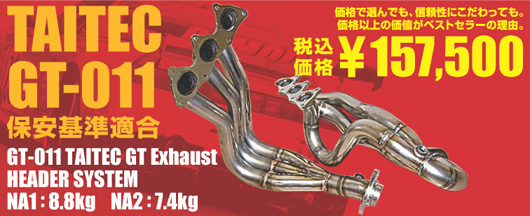
I'll look up the RFY headers dyno's, also FYI GT-One headers are re-branded RF-Y's
Speaking of TaiTec's rear bank, these indeed are complicated and equal, also these fit all type's of NSX, AT and MT 3.2 or 3.0L the replica's are simplified and do not fit AT's.
Please note, Cyl #3 's S curve


That all said KSP & RF-Y do improve on this with better front bank's.
RFY uses a cross over for Cyl #6 location with a S curve crossing the two other cylinders to re configure the pulse out put into the collector.
The RF-Y then uses a special inlet degree angle of the collector to give a broader power/torque curve.
KSP doesn't they use a ultra long smooth collector that narrows the power band up to the top RPM as that's where it's designed for. (gaining perhaps a HP peak but losing in the midrange)
It's hard to convey all the intricacies of both headers with out showing them in real life.
Also a interesting reference point in favor of the RFY, The manifold that most closely matches it's layout of crossing the cylinders and rear bank piping is the Mugen manifold.
Let's not forget that's made by the engineering that made the JGTC, SuperGT and LeMans engines
Also important;
Please consider the complete exhaust line, thus from header to tip, it's a complete package.
The header determines most and sets the "tone" so to speak, yet the muffler finishes the full setup.
For example tubing size, number of bends, total tube length, flow are crucial.
Does the catback have a X pipe or H pipe to balance the pluses? does the exhaust run 6-2-1 or 6-2-2 in configuration
Is a 6-2-2 exhaust unbalanced (TaiTec JGTC, Advance, Comptech V2 etc) or does the 6-2-2 balance the gasses internally (TaiTec GT Lightweight, Comptech V1, GruppeM V1)
Is it a single channel or does it offer variable control (for example RF-Y GT1 can be setup as a 6-2-2 with a variable merger which I would activate off V-Tec ecu feed)
A other interesting note is does the exhaust merge in to a single 6-2-1 section and than back to 6-2-2? (RFY GT-4, GruppeM V2)
Even more unique is a full 6-2-1 exhaust with a large "1" pipe muffler setup, (KSP, GT009 TaiTec)
Speaking of TaiTec's rear bank, these indeed are complicated and equal, also these fit all type's of NSX, AT and MT 3.2 or 3.0L the replica's are simplified and do not fit AT's.
Please note, Cyl #3 's S curve


That all said KSP & RF-Y do improve on this with better front bank's.
RFY uses a cross over for Cyl #6 location with a S curve crossing the two other cylinders to re configure the pulse out put into the collector.
The RF-Y then uses a special inlet degree angle of the collector to give a broader power/torque curve.
KSP doesn't they use a ultra long smooth collector that narrows the power band up to the top RPM as that's where it's designed for. (gaining perhaps a HP peak but losing in the midrange)
It's hard to convey all the intricacies of both headers with out showing them in real life.
Also a interesting reference point in favor of the RFY, The manifold that most closely matches it's layout of crossing the cylinders and rear bank piping is the Mugen manifold.
Let's not forget that's made by the engineering that made the JGTC, SuperGT and LeMans engines
Also important;
Please consider the complete exhaust line, thus from header to tip, it's a complete package.
The header determines most and sets the "tone" so to speak, yet the muffler finishes the full setup.
For example tubing size, number of bends, total tube length, flow are crucial.
Does the catback have a X pipe or H pipe to balance the pluses? does the exhaust run 6-2-1 or 6-2-2 in configuration
Is a 6-2-2 exhaust unbalanced (TaiTec JGTC, Advance, Comptech V2 etc) or does the 6-2-2 balance the gasses internally (TaiTec GT Lightweight, Comptech V1, GruppeM V1)
Is it a single channel or does it offer variable control (for example RF-Y GT1 can be setup as a 6-2-2 with a variable merger which I would activate off V-Tec ecu feed)
A other interesting note is does the exhaust merge in to a single 6-2-1 section and than back to 6-2-2? (RFY GT-4, GruppeM V2)
Even more unique is a full 6-2-1 exhaust with a large "1" pipe muffler setup, (KSP, GT009 TaiTec)
Last edited:
Good info and thanks for the pics.
IIRC, the long, smooth transition is better for mid-range power, while a quicker transition (like the RFY) is better for top-end power. Which is why you see this short transition in Formula-1 cars.
I'm not sure the S-bend on the front bank has any effect since beyond making the primaries the same length, merging a 3-cyl collector is not complicated and does not have the scavanging benefits of a 4-cyl (because there are only 3 evenly spaced pulses).
IIRC, the long, smooth transition is better for mid-range power, while a quicker transition (like the RFY) is better for top-end power. Which is why you see this short transition in Formula-1 cars.
I'm not sure the S-bend on the front bank has any effect since beyond making the primaries the same length, merging a 3-cyl collector is not complicated and does not have the scavanging benefits of a 4-cyl (because there are only 3 evenly spaced pulses).
Here's my dyno results of the NA1 manifold vs NA2 header. Specifically this was a test of the full OEM NA1 manifold, cats and muffler VS the OEM NA2 (off a 2003 year car) headers, cats and muffler. If you assume that the cats and muffler are in the same condition and shape then you can expect ~15whp and ~10 wft-lbs gain across the entire rpm range.
The day I installed it, following this dyno, I did not notice a seat of the pants gain (probably because the power gain was across the entire rev band). After driving it for a few days I thought I might of noticed some gains, but that was probably me mentally telling myself there was gains after spending all that time, money and effort getting them in.
http://www.nsxprime.com/forum/showt...-vs-NA2-OEM-Header-Exhaust-Dyno-inside!/page4
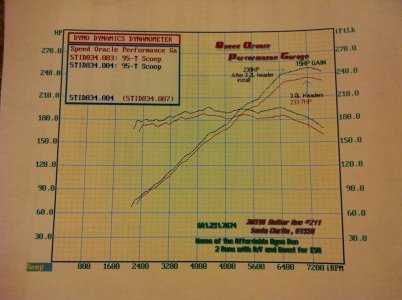
Before:
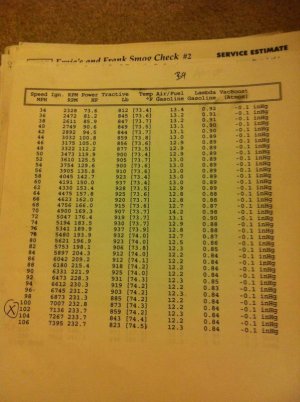
After:
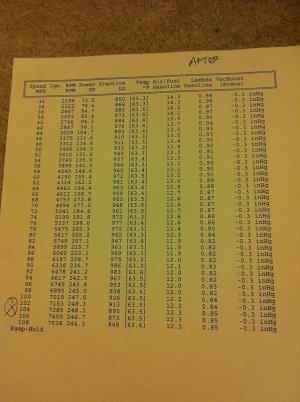
The day I installed it, following this dyno, I did not notice a seat of the pants gain (probably because the power gain was across the entire rev band). After driving it for a few days I thought I might of noticed some gains, but that was probably me mentally telling myself there was gains after spending all that time, money and effort getting them in.
http://www.nsxprime.com/forum/showt...-vs-NA2-OEM-Header-Exhaust-Dyno-inside!/page4

Before:

After:

Last edited:
Seen this in person. Amazing quality.
I'll look up the RFY headers dyno's, also FYI GT-One headers are re-branded RF-Y's
Speaking of TaiTec's rear bank, these indeed are complicated and equal, also these fit all type's of NSX, AT and MT 3.2 or 3.0L the replica's are simplified and do not fit AT's.
Please note, Cyl #3 's S curve


That all said KSP & RF-Y do improve on this with better front bank's.
RFY uses a cross over for Cyl #6 location with a S curve crossing the two other cylinders to re configure the pulse out put into the collector.
The RF-Y then uses a special inlet degree angle of the collector to give a broader power/torque curve.
KSP doesn't they use a ultra long smooth collector that narrows the power band up to the top RPM as that's where it's designed for. (gaining perhaps a HP peak but losing in the midrange)
It's hard to convey all the intricacies of both headers with out showing them in real life.
Also a interesting reference point in favor of the RFY, The manifold that most closely matches it's layout of crossing the cylinders and rear bank piping is the Mugen manifold.
Let's not forget that's made by the engineering that made the JGTC, SuperGT and LeMans engines
Also important;
Please consider the complete exhaust line, thus from header to tip, it's a complete package.
The header determines most and sets the "tone" so to speak, yet the muffler finishes the full setup.
For example tubing size, number of bends, total tube length, flow are crucial.
Does the catback have a X pipe or H pipe to balance the pluses? does the exhaust run 6-2-1 or 6-2-2 in configuration
Is a 6-2-2 exhaust unbalanced (TaiTec JGTC, Advance, Comptech V2 etc) or does the 6-2-2 balance the gasses internally (TaiTec GT Lightweight, Comptech V1, GruppeM V1)
Is it a single channel or does it offer variable control (for example RF-Y GT1 can be setup as a 6-2-2 with a variable merger which I would activate off V-Tec ecu feed)
A other interesting note is does the exhaust merge in to a single 6-2-1 section and than back to 6-2-2? (RFY GT-4, GruppeM V2)
Even more unique is a full 6-2-1 exhaust with a large "1" pipe muffler setup, (KSP, GT009 TaiTec)
Well your in Texas. Just buy them from Mark@Pride. He is in Texas too.
Similar threads
- Locked
- Replies
- 6
- Views
- 706
- Locked
- Replies
- 8
- Views
- 3K
- Replies
- 9
- Views
- 3K
- Replies
- 25
- Views
- 2K
- Replies
- 0
- Views
- 738



